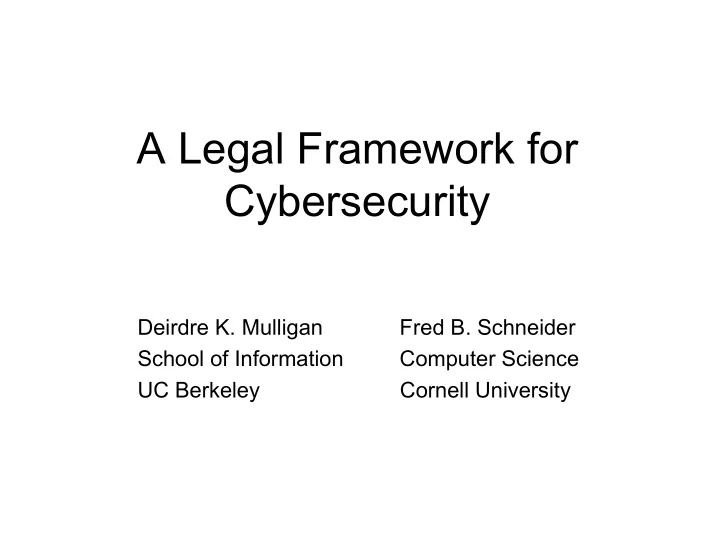

A Legal Framework for Cybersecurity Deirdre K. Mulligan Fred B. Schneider School of Information Computer Science UC Berkeley Cornell University
Outline of Talk • Brief background • Why shift in legal framework is appropriate – Advances in science entering market place – Insufficiency of current law • Why public health-inspired model is appropriate – Similarities of problem space – Similarity of goals • Features of new model – Example interventions • Political environment open to new solutions • Benefits of Public Law • Role of Computer Security community
Background
If you build it they will come… or maybe not… Security in the market place is “remarkably below what “known best Practices” could provide.” The existence of technology solutions on their own does not improve security or privacy.
Advances in Science • Diversity • Type-safe programming languages • Virus checkers • Automatic updates • PKI • Virtualization • Automated diagnostics • firewalls
Insufficiency of current law • Limits of deterrence – theory of crime • Rational actors? Situational? – Identification – Jurisdiction • Limits of security standards – substantive, procedural • Misalignment of resources – Prevention 1st priority b/c no full recover
problem space • Problems of the commons • Constantly evolving threats – Perfection of artifact impossible • Information gaps – Vulnerabilities, threats, investments, losses • Openness, exchange, interaction – necessary for social, economic and political • Complex value trade-offs • Value of prevention – Need to motivate good guys – pits immediate, individual, tangible interests against collective, long-term, statistical probabilities of harm
goals of public health • The mission of public health – “fulfilling society’s interest in assuring conditions in which people can be healthy” The Future of Public Health IOM, 1988 – “to generate organized community effort to address the public interest in health by applying scientific and technical knowledge to prevent disease and promote health” The Future of Public Health IOM, 1988
Goals of cybersecurity • President Obama – “treated as…a strategic national asset.” – “ensure that these networks are secure, trustworthy and resilient.” – “deter, prevent, detect, and defend against attacks” – “recover quickly from any disruptions or damage.”
CS perspective on security • Trust in Cyberspace (2007) : – revisit “the paradigm of ‘absolute security’” – use technology and sound practices to reduce vulnerabilities (introduced insecurity) – wrt inherent insecurity, move toward a model built on three axioms: • insecurity exists; insecurity cannot be destroyed; and, insecurity can be moved around” • A Clean-Slate Design for the Next-Generation Secure Internet (2005): – move away from a fixation on building secure systems – to a more nuanced understanding of the security design space that allows trade-offs among a range of dimensions including • prevention, detection and recovery, resilience and deterrence
policy reorientation Parallel arguments to Public Health: – generate organized community effort • revisit dominant legal focus on the bad guy • address individual actions that create collective insecurity • move from atomized view of security to collective approach to managing insecurity – Apply scientific and technical knowledge to limit vulnerabilities, promote security, and manage insecurity • research on causes of insecurity • fruits of research that makes new forms of intervention possible – Build on insights from CS • build upon CS three axioms of inherent insecurity • relocating insecurity to improve its manageability reduce risk
Prevention Public health strategies targeted regulations conditioning subsidies safe harbors public insurance
Reducing vulnerabilities Producers • Development – Standards • Process, substantive, performance • Post-market – Monitoring – Notification – Issuing patches and patch management • defaults
Reducing vulnerabilities Deployers – Security? • How defined? • Protects what? • At what cost to other(‘s) security?
Insufficiency of prevention • Bug free software is an elusive goal – Vulnerabilities ≠0 – Interaction between components of networks generate new vulnerabilities • Motivated adversaries – Defense in depth – but reality of defend everywhere attack anywhere
Reducing and mitigating vulnerabilities Users • Patch management and Herd Immunity • Intermediaries – Incentives for ISPs? • Liability • Resources – Education – Direct assistance – containment • Configuration management – Ease of updating
inherent insecurity Raising cost of exploitation • Diversity – Natural and artificial – Where? – How?
Inherent insecurity • Detection – Anomaly? – Reporting v. surveillance – testers – Trees and forest
Inherent insecurity • Containment – Accountability • Time scale • binding
Inherent insecurity • research
Inherent insecuriry • Public education – Hygiene – Self-monitoring • Vital signs? • Check-ups? – Monitoring partners • Reporting breaches? Exposures? • Facilitate shielding
Responsive to today’s problems • Reducing vulnerabilities – better development, deployment, after-market maintenance • Dealing with inherent insecurity – need to maintain herd immunity • incentivize, coerce actions that yield collective benefit • deal with “unacceptable” harm to individuals who act to advance collective interest • Conceptualizing value trade-offs, mitigating conflict – interventions to address insecurity present threats to individual interests – Models presented for mitigating tensions
Political will • “From now on, our digital infrastructure - - the networks and computers we depend on every day -- will be treated as they should be: as a strategic national asset. Protecting this infrastructure will be a national security priority.” President Obama
Change in Political Climate • PCCIP • CNCI • 60 Day review • Cybersecurity Act of 2009
Complex Balancing • Value conflicts – Intrusions on core individual liberty and property interests • Communication • Social networking (transactional surveillance) • Privacy • Private property – Access to increasingly essential services • Phone, banking, government etc.
Benefits of Public Law • Political System – Transparent – Participatory – Accountable – Contestable
Moving forward Key time for researchers • Open research questions – Litany of interventions need more info to choose well • Research agenda – Silos v. interdisciplinary • Knowledge transfer not just tech transfer – Demise of OTA; fragmentation of funding – Lack of agency responsible for cybersecurity • ongoing gap in leadership • Lack of clear positive agenda on policy – Importance of participation
Recommend
More recommend